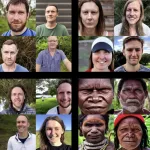(Press-News.org) How many fast-food joints do you come across throughout your day and what does that have to do with your health? A lot, says Abigail Horn, a lead scientist at USC’s Information Sciences Institute (ISI).
Horn led a multidisciplinary team that included researchers from three USC schools (Viterbi School of Engineering; Dornsife College of Letters, Arts and Sciences; and Keck School of Medicine), MIT, and Sabancı University in Turkey; and worked in collaboration with the LA County Department of Public Health. They set out to ascertain whether smartphone mobility (i.e., location) data could provide a way to measure people’s individually-experienced dynamic food environments, at scale across large and diverse populations and diverse physical environments.
Horn explained, “The question was: can we use mobility data to measure people’s visits to food outlets? Because that’s a good proxy for eating food at that outlet. And then, can we go a step further to see whether visits to food outlets observed in the mobility data are predictive of people’s dietary disease rates?”
Location, Location, Location
“It’s well established that the physical environment can impact people’s eating decisions and therefore their diet-related health outcomes, but what we don’t know is the extent to which that is true,” said Horn, who is a Research Assistant Professor in the Daniel J. Epstein Department of Industrial and Systems Engineering at the USC Viterbi School of Engineering.
Physical food environments are the actual spaces where people acquire food. “The food outlets in their neighborhood, or around their workplace, or any location along their daily path. Things like grocery stores, restaurants, or corner markets,” explained Horn.
These environments have been shown to impact people’s diets and therefore health outcomes – including diet-related diseases – in several ways. First, said Horn, “When people have low physical access to healthy foods, that can induce unhealthy choices out of convenience or necessity.” And second, “People can be cued by food environments. So, for example, if throughout your day you’re seeing fast-food outlets over and over again, that can cue or trigger certain behaviors” (i.e., eating more fast food).
There are a number of studies looking at people’s home neighborhood food environments and associating these with food choices and diet-related diseases. But the findings have been mixed, as have the results of public health initiatives that have focused on home neighborhood food environments.
Horn explained, “In the last decade or so, over a billion dollars have been invested in public health interventions in home food environments. This could mean building a grocery store in a food desert [a home neighborhood with limited access to nutritious food] or stocking the corner stores in that neighborhood with fresh fruit and vegetables.” But, she continued, “There’s been no measurable impact in increasing people’s healthy food purchases or health outcomes. So what’s going on here?”
Kayla de la Haye is one of the members of the research team who could help answer that question. De la Haye is the Director of the Institute for Food System Equity at USC Dornsife Center for Economic Research, and has a background in public health, nutrition, and psychology. “One of my roles in this research was to bring expertise in how people make decisions about what to eat, and the consequences of food environments that inundate people with unhealthy options and put them at risk for many diet-related diseases like obesity and diabetes.”
Looking Beyond the Neighborhood Market
De la Haye has worked with families across LA – from Lancaster to LA’s eastside – helping them with strategies to avoid unhealthy foods and adopt healthier eating habits. She said, “So I brought this real-world knowledge of the challenges Angelenos face in eating a healthy diet to our research project.”
The team knew from their own experiences, and from the experiences of families they’ve worked with in healthy eating programs, that people don’t just eat in their home neighborhood. But they needed the data to prove this at the population scale. Horn said, “We thought that the lack of data showing all of the places where people actually go to eat and where they’re spending the most time might explain why we’re not seeing associations between the home neighborhood food environment and people’s diet and health outcomes.”
So they turned to smartphones for the data.
For most of us, our smartphone is always tracking our location, and we probably share that data with several apps. Location data companies aggregate this data – called “mobility data” – and sell it for advertising. But increasingly, it is being made available for research, such as by Spectus.ai through their Social Impact Program, through which the data for this study was obtained.
Esteban Moro led the team at MIT that would help access and analyze this data. Moro, a Research Scientist at MIT Connection Science said, “Our group has a great deal of experience analyzing and using mobility data in problems like segregation, transportation, urban planning, and commercial activity. We are experts in analyzing large datasets of human behavior and transforming them into insightful tools for urban problems. So, our main role in this research was to provide and analyze population-wide mobility data about food consumption.”
Bringing Together All the Data
Using census block data for Los Angeles County to indicate home neighborhoods, and big mobility data to track daily trajectories, the researchers could see all of the proximity – the “exposures” – people would have to food outlets throughout their days.
The team looked specifically at fast-food outlets because fast food is commonly consumed and strongly linked with disease risk. Using “point of interest” data they identified fast-food outlets within LA County. To bring in the health piece of the puzzle, they accessed survey data from the LA County Health Department.
“The Los Angeles County Health Department does a health survey of the LA population every three years. We formed a collaboration with them, and they were able to share anonymized individual level data with us on socio-demographics, obesity rates, diabetes rates, and very importantly, fast-food intake frequency for a representative sample of the LA population,” said Horn.
By analyzing the data, the researchers confirmed that your home neighborhood matters when it comes to your risk of diet-related disease, but so does your commute, the path you take to run your daily errands, how you get from point A to point B and all the way to point Z in your day, and what those points are.
The Results?
“We know there is a relationship between fast-food outlet visits and fast-food intake, as well as between fast-food intake and diet-related diseases, but wow, this data source does a really good job of capturing that!” said Horn.
Moro elaborated, “The most surprising result is that mobility data works like a “honest signal,” i.e., visits to fast-food outlets were a better predictor of individuals’ obesity and diabetes than their self-reported fast-food intake, controlling for other known risks.”
De la Haye emphasized, “This work demonstrates that large-scale mobility data is in fact a valuable indicator of where and what people eat, and their risk for diet-related disease.”
Why is this so significant?
De la Haye explained, “Measuring what people eat is really difficult. In fact, many large public health surveys and surveillance tools have stopped asking people about their food intake because the data is often unreliable (in part because people often forget the details of what they ate, and also because they don’t always want to tell researchers about their less healthy food choices). So, this gives us a new tool to track dietary patterns, like eating fast food, for large populations such as residents of cities, counties, or the entire country.”
What’s Next?
“What I’m excited about as a researcher,” said Horn, “is that this opens up mobility data for all kinds of investigations into the food environment. Things like: where are people getting food at different times of day? Who are these people? When are they most influenced by the options available (or unavailable) to them? We can really investigate this with big mobility data, because it allows us to look at eating behaviors in large and new dimensions: at scale across the population, across diverse population groups, diverse environmental surroundings, and over long periods of time.”
De la Haye underscores the importance of this, “data on population dietary patterns is a powerful tool needed to make public health programs and policies, and ultimately reduce health risks from one of the leading causes of illness and death in the U.S.: unhealthy diets.”
The research team’s paper, Population mobility data provides meaningful indicators of fast food intake and diet related diseases in diverse populations, has been published in Nature Partner Journals (npj) Digital Medicine.
END
Are you at risk for diet-related disease? Where you spend your day plays a role
A USC and MIT led research team finds smartphone mobility data to be a good predictor of diet and diet-related disease
2023-11-30
ELSE PRESS RELEASES FROM THIS DATE:
Harvard report proposes comprehensive plan for Lebanon’s economic recovery
2023-11-30
Harvard's Growth Lab has released a new report on Lebanon's struggling economy that revisits the origins of the crisis and proposes a comprehensive plan for a swift economic recovery. The research project, led by Professors Ricardo Hausmann, Ugo Panizza, and Carmen Reinhart, provides a clear diagnostic of the ongoing crisis and suggests novel, out-of-the box solutions.
The research highlights the unusual depth of Lebanon’s economic collapse. According to Professor Hausmann, “Lebanon faces a triple financial crisis: its currency has collapsed, its banking system is bankrupt, and the government has defaulted on its debt. The ...
Substance abuse treatment helps reduce reported methamphetamine use among men who have sex with men
2023-11-30
A nearly decade-long study by UCLA researchers found that substance abuse treatment of any kind may help to reduce methamphetamine usage among men who have sex with other men – a population that has been disproportionately impacted by the U.S. methamphetamine crisis in recent years.
The findings come from the mSTUDY, funded by the National Institute on Drug Abuse (NIDA), and are published in the Journal of Substance Use and Addiction Treatment. The study analyzed responses from a group of nearly 300 men in Los Angeles who self-reported ...
Community scientists needed: help improve winter weather predictions
2023-11-30
Community members across Utah, the Great Basin, and around Lake Erie and Lake Ontario are invited to join people across the country in contributing winter weather observations. The data is collected by scientists for a NASA-funded project that seeks to improve the accuracy of winter weather predictions.
Information collected by community scientists will help researchers from Lynker, DRI, and the University of Nevada, Reno, improve the technology that drives predictions for when precipitation will fall as rain or snow. Currently, satellite technologies struggle to differentiate snow from rain near the freezing point in mountainous ...
C-Path’s Translational Therapeutics Accelerator and Celdara Medical announce pipeline-focused MOU
2023-11-30
TUCSON, Ariz. and LEBANON, N.H., November 29, 2023 — Critical Path Institute’s (C-Path) Translational Therapeutics Accelerator (TRxA) and Celdara Medical today announced the signing of a Memorandum of Understanding (MOU) aimed at identifying and advancing promising new therapeutics in areas of high unmet medical need. Under the terms of this agreement, both organizations look to expand opportunities to provide financial support for the development of early-stage therapeutics by exchanging non-competitive information submitted in academic funding proposals.
Launched ...
AI image generator Stable Diffusion perpetuates racial and gendered stereotypes, study finds
2023-11-29
What does a person look like? If you use the popular artificial intelligence image generator Stable Diffusion to conjure answers, too frequently you’ll see images of light-skinned men.
Stable Diffusion’s perpetuation of this harmful stereotype is among the findings of a new University of Washington study. Researchers also found that, when prompted to create images of “a person from Oceania,” for instance, Stable Diffusion failed to equitably represent Indigenous peoples. Finally, the generator tended to sexualize images of women from certain Latin American countries (Colombia, Venezuela, Peru) as well as those from Mexico, India and Egypt.
The researchers will present ...
ORNL joins consortium to tackle scientific AI’s next great milestone
2023-11-29
The Department of Energy’s Oak Ridge National Laboratory has joined a global consortium of scientists from federal laboratories, research institutes, academia and industry to address the challenges of building large-scale artificial intelligence systems and advancing trustworthy and reliable AI for scientific discovery.
The partnership, known as the Trillion Parameter Consortium, or TPC, seeks to grow and improve large-scale generative AI models aimed at tackling complex scientific challenges. These include the development of scalable model architectures and related training strategies, as well as data organization ...
UT Health San Antonio launches Center for Global and Community Oral Health
2023-11-29
The School of Dentistry of The University of Texas Health Science Center at San Antonio has launched the Center for Global and Community Oral Health, designed to bring together various existing outreach and research programs under one umbrella to study and develop solutions to the most pressing dental challenges facing the global population.
“Our vision is to transform community and global oral health through education, research and innovation,” said Brij B. Singh, PhD, associate dean of research for the dental ...
Breakthrough study shows exercise improves cognitive health for people with Down syndrome
2023-11-29
An exploratory study has shown that light, regular exercise can improve the cognitive, as well as physical, health of adults with Down syndrome.
The Mindsets study, published today [29 November] in the International Journal of Environmental Research and Public Health, is the first to investigate the effects of physical and cognitive exercise on people with Down syndrome, and it found that short bursts of walking can lead to improved information processing and attention after just eight weeks.
The role that exercise can play in cognitive growth represents a breakthrough in thinking about what’s ...
Long-standing hormone treatment for donated hearts found to be ineffective
2023-11-29
Doctors managing deceased organ donors routinely treat the donors’ bodies with thyroid hormones in a bid to preserve heart function and increase the quantity and quality of hearts and other organs available for transplantation. However, according to a recent clinical trial led by researchers at Washington University School of Medicine in St. Louis and Mid-America Transplant in St. Louis, routine thyroid hormone intervention is not effective at achieving these goals, and may even cause harm.
The study is published Nov. 30 in The New England Journal of Medicine.
“There have been ...
Catalysts of change: Young scientists spearhead breakthrough COVID-19 research in international collaboration
2023-11-29
A recent groundbreaking study, published in Nature Nanotechnology, sheds new light on the coronavirus's behavior, particularly its ability to remain attached under various mechanical stresses and the implications for person-to-person transmission. The paper, titled “Single-molecule force stability of the SARS-CoV-2–ACE2 interface in variants-of-concern,” is the result of a collaborative effort led by scientists from Auburn University, Ludwig Maximilian University of Munich, and Utrecht University. This research offers an unprecedented molecular-level understanding of the virus and raises ...
LAST 30 PRESS RELEASES:
The vast majority of US rivers lack any protections from human activities, new research finds
Ultrasound-responsive in situ antigen "nanocatchers" open a new paradigm for personalized tumor immunotherapy
Environmental “superbugs” in our rivers and soils: new one health review warns of growing antimicrobial resistance crisis
Triple threat in greenhouse farming: how heavy metals, microplastics, and antibiotic resistance genes unite to challenge sustainable food production
Earthworms turn manure into a powerful tool against antibiotic resistance
AI turns water into an early warning network for hidden biological pollutants
Hidden hotspots on “green” plastics: biodegradable and conventional plastics shape very different antibiotic resistance risks in river microbiomes
Engineered biochar enzyme system clears toxic phenolic acids and restores pepper seed germination in continuous cropping soils
Retail therapy fail? Online shopping linked to stress, says study
How well-meaning allies can increase stress for marginalized people
Commercially viable biomanufacturing: designer yeast turns sugar into lucrative chemical 3-HP
Control valve discovered in gut’s plumbing system
George Mason University leads phase 2 clinical trial for pill to help maintain weight loss after GLP-1s
Hop to it: research from Shedd Aquarium tracks conch movement to set new conservation guidance
Weight loss drugs and bariatric surgery improve the body’s fat ‘balance:’ study
The Age of Fishes began with mass death
TB harnesses part of immune defense system to cause infection
Important new source of oxidation in the atmosphere found
A tug-of-war explains a decades-old question about how bacteria swim
Strengthened immune defense against cancer
Engineering the development of the pancreas
The Journal of Nuclear Medicine ahead-of-print tip sheet: Jan. 9, 2026
Mount Sinai researchers help create largest immune cell atlas of bone marrow in multiple myeloma patients
Why it is so hard to get started on an unpleasant task: Scientists identify a “motivation brake”
Body composition changes after bariatric surgery or treatment with GLP-1 receptor agonists
Targeted regulation of abortion providers laws and pregnancies conceived through fertility treatment
Press registration is now open for the 2026 ACMG Annual Clinical Genetics Meeting
Understanding sex-based differences and the role of bone morphogenetic protein signaling in Alzheimer’s disease
Breakthrough in thin-film electrolytes pushes solid oxide fuel cells forward
Clues from the past reveal the West Antarctic Ice Sheet’s vulnerability to warming
[Press-News.org] Are you at risk for diet-related disease? Where you spend your day plays a roleA USC and MIT led research team finds smartphone mobility data to be a good predictor of diet and diet-related disease




